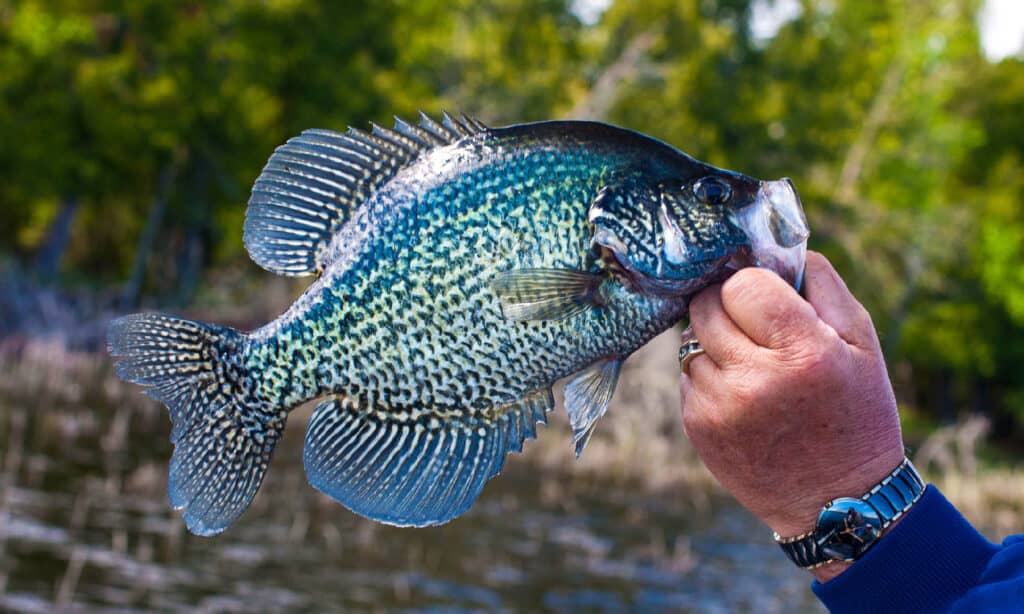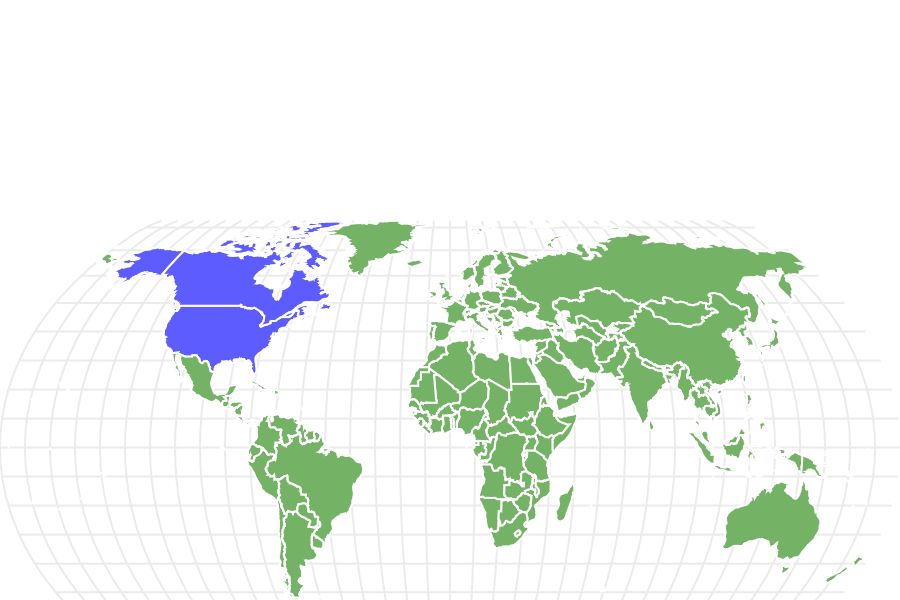Black crappie fish can hybridize with white crappie, resulting in a closely related species.
Advertisement
Black Crappie Scientific Classification
- Kingdom
- Animalia
- Phylum
- Chordata
- Class
- Actinopterygii
- Order
- Perciformes
- Family
- Centrarchidae
- Genus
- Pomoxis
- Scientific Name
- Pomoxis nigromaculatus.
Read our Complete Guide to Classification of Animals.
Black Crappie Conservation Status
Black Crappie Facts
- Name Of Young
- FRY
- Fun Fact
- Black crappie fish can hybridize with white crappie, resulting in a closely related species.
- Biggest Threat
- Largemouth Bass, eagles, otters and turtles
Black Crappie Physical Characteristics
- Color
- Black
- Green
- Silver
- Skin Type
- Scales
- Age of Sexual Maturity
- 2-4 years of age
View all of the Black Crappie images!
The black crappie is a freshwater fish native to North America. It is a prized sport fish because it grows quickly, is simple to catch, and is tasty. Black crappies have a maximum length of 20 inches and a maximum lifespan of eight years. Black crappies usually live in clear lakes, ponds, and rivers that move slowly. They eat small fish and insects. When the water is 60-65° F, they spawn in the spring. The distinctive black spots and silver-gray bodies of black crappies camouflage them in their natural environments.
Facts About Black Crappie
- Black crappie can hybridize with white crappie, resulting in a closely related species.
- They can lay over 100,000 eggs in a single spawning season.
- Their preferred water temperature is around 68-77°F.
- The black crappie is a critical species in many aquatic food webs, providing a food source for larger predators like birds and other fish.
Black Crappie Classification and Scientific name
The black crappie belongs to the class Actinopterygii and the family Centrarchidae. The scientific name of the black crappie is Pomoxis nigromaculatus.
Black Crappie Appearance
Black crappies have a typical sunfish appearance, with a slightly elongated and compressed body shape, a large dorsal fin, and a small mouth. They have silvery-green to black coloration with vertical bars and large, dark spots on their body’s dorsal (upper) side. The average length of a black crappie fish is 7-12 inches, and they can weigh up to two pounds.

Black crappie fish can be found in the Mississippi River Basin, the Great Lakes region and the Mid-Atlantic states.
©iStock.com/SteveOehlenschlager
Distribution, Population, and Habitat
Black crappie fish are widely distributed across North America. They are located in a variety of habitats, including large rivers, small streams, and still-water bodies. Black crappie fish are abundant in the following:
- Mississippi River Basin
- Great Lakes region
- Mid-Atlantic states.
Black crappie populations can vary greatly depending on the region and habitat conditions. They are commonly found in large numbers in suitable habitats and are abundant in many parts of their range. However, overfishing, habitat degradation, and the presence of non-native species can negatively impact their populations.
Black crappies prefer clear, calm water with abundant vegetation, such as aquatic plants, logs, and overhanging trees. They can tolerate a range of water temperatures that range between 68-77 degrees. Therefore, they can adapt to various habitat types, including lakes, rivers, reservoirs, and ponds, as long as they have a good food source and suitable spawning habitat.
Evolution and History
The term crappie is sometimes spelled croppie or crappé. It comes from the Canadian-French word “crapet,” which refers to several different members of the sunfish family. The fish was originally native to Canada and northeastern parts of the U.S. Today it has been transplanted to 48 U.S. states.
Black Crappie Predators and Prey
Throughout their life cycle, Black crappie is prey to several predators such as:
- Largemouth bass, northern pike, and walleye.
- Birds, such as ospreys, eagles, and herons.
- Turtles, such as painted and map turtles.
- Mammals, such as muskrats and otters.
The adult black crappie is also vulnerable to commercial and recreational fishing pressures, which can impact their populations. In addition, juvenile black crappie is more susceptible to predation, as they are smaller and more accessible for predators to catch. Despite these threats, black crappie populations are generally stable and considered a valuable resource for sport fishing.
Black crappie feed on a variety of prey items, including:
- Small fish, such as minnows and shad
- Crustaceans, such as crawfish and crayfish
- Aquatic insects, such as dragonflies and damselflies
- Zooplankton, such as small crustaceans and rotifers
They feed primarily during the day, using their giant mouths and sharp teeth to capture prey. Juvenile black crappies feed on smaller prey items, such as zooplankton and insects, while adult black crappies consume larger prey, including other fish. Black crappies eat most actively in the warmer months when water temperatures are suitable.
Reproduction and Lifespan
Black crappie reproduction stages include:
- Spawning: Black crappies begin to generate when water temperatures reach the suitable range. They form large schools near spawning beds, typically located near underwater structures such as rocks, stumps, or logs.
- Egg laying: Female black crappies spread their eggs on the spawning bed, typically in large clusters. They can lay over 100,000 eggs in a single spawning season.
- Fertilization: Male black crappies fertilize the eggs by releasing milt over the eggs. The males then guard the eggs.
- Hatching: The eggs hatch within 2-4 days, and the fry emerges. They are about ¼ inch long and are immediately able to swim and feed.
- Juvenile stage: Juvenile black crappies reach a length of 5-6 inches within their first year. They feed on smaller prey items, such as zooplankton and insects, and continue to grow and mature into adulthood.
The average lifespan of black crappie is 5-8 years, although some of these fish can live up to 10 years in the wild. Various factors, including environmental conditions, availability of food, and fishing pressures, influence the lifespan of black crappies. For example, juvenile black crappies face higher mortality rates due to predation, while adult black crappies are more vulnerable to fishing pressures and changes in their habitat.
Fishing and Cooking
The black crappie is popular among recreational anglers and is often chosen for size, taste, and fighting ability. They are often caught using various fishing methods, including casting, trolling, and jigging, with live bait or lures. They are also seen using a variety of fishing gear, including spinning reels, baitcasting reels, and fly-fishing equipment. Black crappies are most active during the warmer months and can be found in various habitats, including lakes, rivers, and reservoirs.
Black crappies are prized for their delicate flavor and are used in various cooking methods, including baking, frying, and grilling. They are typically filleted and skinned before cooking and can be seasoned to taste with herbs, spices, and other flavorings. Some popular dishes include black crappie cakes, black crappie fillets with lemon butter sauce, and black crappie chowder.
When cooking and eating black crappie, it is essential to note that they are freshwater fish and may contain contaminants, such as mercury and other pollutants. Therefore, follow local guidelines for safe consumption, especially for pregnant women and young children.
Population
The black crappie is not listed as a species under threat on the IUCN Red List.
Related Animals
View all 285 animals that start with BBlack Crappie FAQs (Frequently Asked Questions)
How many eggs can a black crappie lay?
They can lay over 100,000 eggs in a single spawning season.
What is the appearance of black crappie?
Black crappie has a typical sunfish appearance, with a slightly elongated and compressed body shape, a large dorsal fin, and a small mouth. They have silvery-green to black coloration with vertical bars and large, dark spots on their body’s dorsal (upper) side.
Where do black crappie fish live?
Large rivers, small streams, and still-water bodies.
Thank you for reading! Have some feedback for us? Contact the AZ Animals editorial team.
Sources
- University of Florida, Available here: https://www.floridamuseum.ufl.edu/discover-fish/species-profiles/pomoxis-nigromaculatus/
- University of Michigan, Available here: https://animaldiversity.org/accounts/Pomoxis_nigromaculatus/
- Missouri Department of Conservation, Available here: https://mdc.mo.gov/discover-nature/field-guide/crappie-black
- New York Upstate, Available here: https://www.newyorkupstate.com/outdoors/2021/06/crappie-how-did-this-popular-tasty-game-fish-get-such-a-lousy-name.html

















